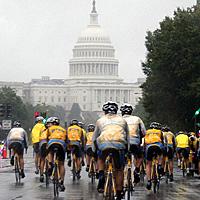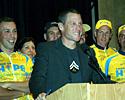
Recently on Cyclingnews.com |
Tales from the peloton, October 12, 2005
Tour of Hope - Armstrong's true legacy
After riding nine consecutive centuries in a trek across the United States that began in San Diego on Thursday, September 29th, 24 cancer survivors, advocates, caregivers and physicians were scheduled to cross a finish line at the White House Ellipse in Washington D.C. for the finale of the Tour of Hope on Saturday. Cyclingnews' Steve Medcroft was there to welcome riders from across the country as they arrived in Washington.

|
Unfortunately for event planners, however, all outdoor events had to be a cancelled after two days of rain soaked the Ellipse lawn and made local roads unsafe for cyclists. So in the place of informational booths and a stage large enough for Armstrong's rock-star celebrity status, Tour of Hope organisers took over the JW Marriot Hotel - just one block from the White House on Pennsylvania Avenue and 15th Street - and managed to erect a stage, PA system and monitors in time for Armstrong to address the crowd.
The Tour riders stepped off their bikes after riding (in the rain) a final eight mile journey, and were greeted by a surprising 1000-strong crowd of well wishers, supporters and local riders.
Armstrong was in his element on stage. In a time when the world's greatest Tour de France champion is dealing with attempts to tarnish his legacy as a cyclist, the cancer community still draws inspiration from his story of survival. "The cancer community doesn't care what a French newspaper has to say," said Dana Matassa, a member of the canceled 50-mile D.C. fundraising ride, who stood 20 feet from Armstrong in the crowded hotel ballroom. "Lance Armstrong became a symbol to the cancer community because he gives us the ability to believe that everything will be OK, that we can beat this disease. What a French newspaper says about him really becomes secondary."

|
Matassa was on hand at the event because he had raised thousands of dollars for the cause the Tour promotes - clinical trials and cancer research. Like thousands of other cyclists, cancer survivors and cancer-community members, Matassa, a Cat 3 racer and long-time cyclist, says Armstrong's amazing character had always impressed him. But it was his own closeness to cancer that inspired him to join the ride.
"My best friend in the world died this year," the 37 year-old D.C. resident said. "That person was my father Ron. He died April 27th after battling prostate cancer."
As a cyclist, Armstrong's cancer message was always second to Matassa's admiration of Armstrong as a cyclist. "Then my father came down with prostate cancer about three years ago," Matassa said. "He had surgery but the cancer had spread; some had gotten out. He went through radiation and got really sick on the chemo."
For a while, the elder Matassa seemed to recover, even going to his 50th high school reunion in Baltimore. But in 2005, Ron Matassa relapsed. "He got pneumonia in January. They said he had only weeks left but he made it to his 70th birthday (March 9th). He then developed an infection and died."

|
Joining the Tour of Hope fundraising effort was one way Matassa channeled the grief of losing his father. "My father was a Lance fan. Every time he went to chemo, he would give out yellow bands. Every time he had a setback in his treatment, he would say that if Lance can come through it, why can't I? It was his motto." said Matassa. He believes Armstrong showed people struggling with some of the horrors of cancer that the battle is never truly over; that they can survive.
Matassa began his fundraising with a simple email message about his father to his teammates on the D.C.-based Squadra Coppi Cycling Club. "I had a great response," he said. "The guys gave and gave; one guy gave a thousand dollars." Encouraged, Matassa expanded his range. "A big breakthrough came from the people I work with (Matassa is an outside sales rep for Staples). I sent the email to a couple of vice presidents. They not only gave a couple hundred dollars to the cause but allowed me to attach my email to communications I had with other people inside the company. Word spread and I started getting all kinds of donations from people I didn't even know. They were sending me email about how they were affected by my story; telling me how they were affected by cancer."
In all, Matassa raised over $7,300; contributing to a pool of funds raised to support cancer research and the funding of clinical trials that is expected to end up over $2 million. Although the 50-mile charity ride was cancelled due to safety concerns, the money raised was recognised at ceremony in the ballroom at the JW Marriot.
Started in 2003 as an awareness campaign for the importance of clinical trials in cancer research, Tour of Hope organisers received more than a thousand applications from cyclists wanting to ride the 2005 route. Each of the final selection, a collection of cancer survivors, caregivers, researchers, doctors and nurses, has what organisers considered a unique commitment and story about cancer. From Becky Lamph, a 37 year-old homemaker from Las Vegas, who survived thyroid cancer only to see her young daughter struggle with leukemia, to 58 year-old cancer researcher Harry Slocum, the group was comprised of people passionate about cycling who all shared the bond of cancer.

|
Armstrong himself contributed to the effort by more than just lending his name, the energy of his Lance Armstrong Foundation and his connections to leading sponsors Bristol-Myers Squibb, Trek Bicycles, Discovery Health Channel, Nike and so on. He contributed in the most fitting way he could - by getting on his bike and joining the ride at predetermined spots along the route.
So even though his story is arguably the biggest success in oncology, Armstrong's legacy may be his contribution to the fight against cancer though people like Matassa. "The Tour de France is about Lance Armstrong and the Tour of Hope is about surviving cancer," Matassa said. "It was inspirational to see the riders finish. Magic. The riders are like rock stars. They finished their ride and walked into the JW Marriott on Saturday and they were bigger than Lance Armstrong ever will be. Lance is the catalyst - I appreciate Lance for giving us an opportunity to be a part of this very special opportunity - but the riders are the real inspiration."
Armstrong's legacy will continue to grow through people like Matassa and the Tour of Hope team. Matassa says he'll try to join the 2006 Tour of Hope as one of the select cross-country riders. "If I don't make the actual team, I'll still raise money locally," he said.
Photography
For a thumbnail gallery of these images, click here
Images by Dana Matassa
- Cat 3 racer Dana Matassa raised more than $7,300 for the Tour of Hope's main cause; cancer research and clinical trials, after his father Ron passed away from prostate cancer
Images by Chris Brewer/www.thepaceline.com
- Along the nine-day, 2,500-mile Tour of Hope route the 24 team members were met with rallies, events and sometimes just groups of well wishers.
- Armstrong's former teammate George Hincapie lent his star power to the rained-out D.C. finale of the 2005 Tour of Hope.
- The Tour of Hope's 24 team members rode a shortened eight-mile final course to the steps of the Capitol Building then ultimately to a ballroom at the JW Marriot hotel just one block from the White House at Pennsylvania Avenue and 15th Street.
- Joined by select VIP's the Tour of Hope team approaches the Capitol in Washington D.C.
- Armstrong addresses the Tour of Hope faithfuls at the JW Marriot in downtown Washington D.C.
